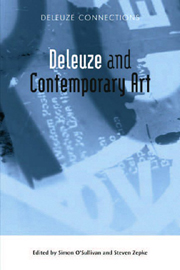Book contents
- Frontmatter
- Contents
- Acknowledgements
- List of Illustrations
- Introduction: Deleuze and Guattari and Contemporary Art
- POLITICS
- 1 The Politics of the Scream in a Threnody
- 2 A Shift Towards the Unnameable
- 3 The Heterogenesis of Fleeing
- 4 Anita Fricek: Contemporary Painting as Institutional Critique
- THE AESTHETIC PARADIGM
- SCENES AND ENCOUNTERS
- TECHNOLOGIES
- Notes on Contributors
- Index
4 - Anita Fricek: Contemporary Painting as Institutional Critique
from POLITICS
Published online by Cambridge University Press: 12 September 2012
- Frontmatter
- Contents
- Acknowledgements
- List of Illustrations
- Introduction: Deleuze and Guattari and Contemporary Art
- POLITICS
- 1 The Politics of the Scream in a Threnody
- 2 A Shift Towards the Unnameable
- 3 The Heterogenesis of Fleeing
- 4 Anita Fricek: Contemporary Painting as Institutional Critique
- THE AESTHETIC PARADIGM
- SCENES AND ENCOUNTERS
- TECHNOLOGIES
- Notes on Contributors
- Index
Summary
The strong always have to be defended against the weak.
Friedrich Nietzsche, The Will to PowerOne place we might start a Deleuzian discussion of Contemporary art is with his definition of the ‘contemporary’. For Deleuze the ‘contemporary’ is an ontological rather than chronological term, marking the emergence of something new as the construction and expression of being in becoming. As a result, ‘contemporary’ art produces sensations that exceed any pre-given conditions of possibility, in a genetic ‘event’ that constructs a new future. ‘Contemporary’ art is forever out of time, ‘to come’, an ‘absolute deterritorialization’ that ‘summons forth a new people’ (Deleuze and Guattari 1994: 99). In this sense, Guattari suggests that instead of speaking of ‘Contemporary art’ we should speak of an ‘Atemporal art’ (Guattari 1994: 64), one whose criteria are not history, medium, technique or content, but creativity. The ‘contemporary’ in art would therefore emerge, according to Deleuze, as part of a tradition of the ‘new’, one which was not defined by the traditions of ‘art’, but neither was it denied to them. So although it is tempting to see the tradition of the new as equating with the avant-garde trajectory, the ‘contemporary’ in art does not emerge simply through a critique of the present, or of its history, which both retain the ‘before’ as the condition of any conceivable ‘after’.
If the avant-garde sought to overcome the boundaries of ‘art’ in order to operate directly within, and as, ‘life’, it did so by defining these through a concept of ‘art as institution’ encompassing ‘the productive and distributive apparatus and also to the reception of works’.
- Type
- Chapter
- Information
- Deleuze and Contemporary Art , pp. 63 - 82Publisher: Edinburgh University PressPrint publication year: 2010

